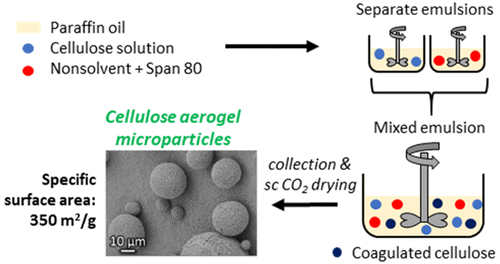当前位置:
X-MOL 学术
›
Biomacromolecules
›
论文详情
Our official English website, www.x-mol.net, welcomes your
feedback! (Note: you will need to create a separate account there.)
Cellulose Aerogel Microparticles via Emulsion-Coagulation Technique.
Biomacromolecules ( IF 5.5 ) Pub Date : 2020-02-13 , DOI: 10.1021/acs.biomac.9b01725 Lucile Druel 1 , Amelie Kenkel 1, 2 , Victor Baudron 2 , Sytze Buwalda 1 , Tatiana Budtova 1
Biomacromolecules ( IF 5.5 ) Pub Date : 2020-02-13 , DOI: 10.1021/acs.biomac.9b01725 Lucile Druel 1 , Amelie Kenkel 1, 2 , Victor Baudron 2 , Sytze Buwalda 1 , Tatiana Budtova 1
Affiliation

|
Cellulose aerogel microparticles were made via emulsification/nonsolvent induced phase separation/drying with supercritical CO2. Cellulose was dissolved in NaOH-based solvent with and without additives in order to control solution gelation. Two emulsions, cellulose solution/oil and cellulose nonsolvent/oil, were mixed to start nonsolvent induced phase separation (or coagulation) of cellulose inside each cellulose droplet leading to the formation of so-called microgels. Different options of triggering coagulation were tested, by coalescence of droplets of cellulose solution and cellulose nonsolvent and by diffusion of nonsolvent partly soluble in the oil, accompanied by coalescence. The second option was found to be the most efficient for stabilization of the shape of coagulated cellulose microgels. The influence of gelation on particle formation and aerogel properties was investigated. The aerogel particles' diameter was around a few tens of microns, and the specific surface area was 250-350 m2/g.
中文翻译:

通过乳液混凝技术的纤维素气凝胶微粒。
通过乳化/非溶剂诱导的相分离/超临界CO 2干燥制备纤维素气凝胶微粒。将纤维素溶解在有或没有添加剂的NaOH基溶剂中,以控制溶液的凝胶化。混合两种乳液,纤维素溶液/油和纤维素非溶剂/油,以开始非溶剂诱导的每个纤维素小滴内的纤维素的相分离(或凝结),导致形成所谓的微凝胶。通过纤维素溶液和纤维素非溶剂液滴的聚结以及部分溶解在油中的非溶剂扩散并聚结,测试了引发凝结的不同方法。发现第二种选择对于稳定凝结的纤维素微凝胶的形状是最有效的。研究了凝胶化对颗粒形成和气凝胶性质的影响。气凝胶颗粒的直径约为几十微米,比表面积为250-350平方米/克。
更新日期:2020-02-03
中文翻译:

通过乳液混凝技术的纤维素气凝胶微粒。
通过乳化/非溶剂诱导的相分离/超临界CO 2干燥制备纤维素气凝胶微粒。将纤维素溶解在有或没有添加剂的NaOH基溶剂中,以控制溶液的凝胶化。混合两种乳液,纤维素溶液/油和纤维素非溶剂/油,以开始非溶剂诱导的每个纤维素小滴内的纤维素的相分离(或凝结),导致形成所谓的微凝胶。通过纤维素溶液和纤维素非溶剂液滴的聚结以及部分溶解在油中的非溶剂扩散并聚结,测试了引发凝结的不同方法。发现第二种选择对于稳定凝结的纤维素微凝胶的形状是最有效的。研究了凝胶化对颗粒形成和气凝胶性质的影响。气凝胶颗粒的直径约为几十微米,比表面积为250-350平方米/克。











































 京公网安备 11010802027423号
京公网安备 11010802027423号